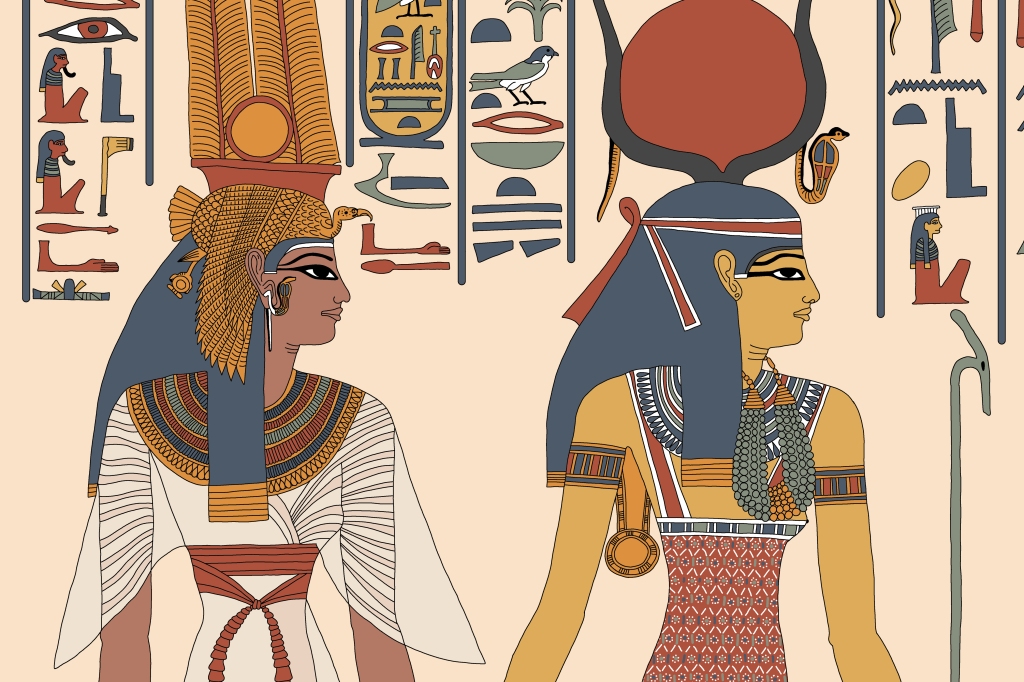
Tomb QV66 located in the Valley of the Queens is one of the largest and most lavishly decorated in Egypt’s history. It was built as the final resting place for the favourite queen of Ramesses II, Nefertari Meritenmut (“Beautiful Companion, Beloved of the Goddess Mut”), who lived around 1279-1213 BC. She held the title of “King’s Great Wife”, meaning she was favoured of Ramesses eight wives, who described her as “the one for whom the sun shines”.
Within her tomb, Nefertari is shown being welcomed by the gods of Egypt, who guide her to the afterlife by giving directions and performing ceremonies and tests from the Book of the Dead. The scenes describe the journey from her death up until the end when she is reborn and emerges from the eastern horizon like a sun disc.
In this scene from the northeast wall of the vestibule, Nefertari is being led by the goddess Isis, who says: “By my hand, come, Great Wife of the King, Nefertari Meritenmut, true of voice, to a place in the sacred land”. She is being presented to the beetle-headed sun-god Khepri who says: “I give to you eternity like Ra, I give to you the appearance of Ra in heaven, I give to you a place in the sacred land”.
Queen Nefertari
Queen Nefertari wears a long and semi-transparent white dress typical of the elaborate fashions of the Ramesside court at the time, tied at the middle with a red sash. Around her neck, Nefertari wears a broad collar of gold, faience, carnelian and turquoise, and her wrists are decorated with blue and white bracelets.

On top of her tripartite wig, she wears her characteristic headdress featuring a gold Nekhbet vulture holding the shen symbol in its claws representing eternity. Above this is a red mortar surmounted by two tall gold feathers with a solar disc at the centre.
The hieroglyphs surrounding her are essentially a label identifying Nefertari by her name contained within a cartouch, and describing what she is doing (read from top right and down columns to left):
Hm.t nsw.t wr.t nb.t tA.wy (Nfr.t-iry mr(y).t n Mw.t)| mAa(.t)-xrw xr Wsir nTr aA
Great Wife of the King, Lady of the Two Lands, Nefertari Meritenmut, true of voice, in the presence of Osiris, the great god.
Goddess Isis
Nefertari is being led by the hand by the goddess Isis, who is shown wearing the sun-disk and cow horn headdress more typically associated with the goddess Hathor, which has a uraeus cobra symbolising divine authority. This is emphasised by the was-sceptre she holds in her left hand, which symbolises power and is often depicted as being carried by gods, kings, and priests.
Her arms are decorated with bracelets made of carnelian and turquoise set in gold and around her neck is a broad necklace with a counterweight that hangs down her back, known as a menat. These were held in the hand by the counterpoise and used as a rattle by the priestesses of Hathor and were also worn in life to foster fruitfulness and good health, and in death to provide protection in the afterlife.

Isis wears a tight-fitting, red dress with a lozenge pattern which is thought to represent a bead-net dress. The beads are cylinders of blue or green faience, which was either sewn onto a linen dress or worked into a separate net worn over the linen. In art, the bead-net dresses are fairly common in the Old and Middle Kingdoms but decline in number during the New Kingdom.

The hieroglyphics surrounding her describe the words Isis is speaking to Nefertari:
Dd mdw in As.t m-a i ir.t Hm.t nsw.t wr.t (Nfr.t-iry mr(y).t n Mw.t)| [mAa(.t)-xrw] n S.t m tA Dsr
Words spoken by Isis: By my hand, come, Great Wife of the King, Nefertari Meritenmut, true of voice, to a place in the sacred land.
God Khepri
Isis and Nefertari are standing before a beetle-headed god who sits upon a colourful throne. This is Khepri, a god who represented the rising or morning sun, and by extension, the creation and the renewal of life.
The throne upon which Khepri sits features a sema-tawy symbol in the bottom right-hand corner, combining a knotted papyrus plant representing Upper Egypt and a sedge plant representing lower Egypt to signify the unity of the two lands. The throne itself sits upon a reed mat, which in turn sits upon a dais which forms the shape of the hieroglyph for Maat which embodies the concepts of truth, balance and order.
In his right hand, he holds the same was-sceptre as Isis and a colourful artificial tail was also attached to his belt. In his left hand, he holds an ankh, the symbol for life, a reference which is reinforced by the small tyet symbol, or Isis knot, which is tucked into Kehpri’s belt.
The hieroglyphics above his head give his name and title, and those to the left record his words to Nefertari:
Column 1: Dd mdw Di.n[=i] n[=T] nHH mi-Ra
Words Spoken: “I have given to you eternity, like Re”Column 2: Dd mdw Di.n[=i] n[=T] xaa Ra m p.t
Words Spoken: “I have given to you the appearance of Re in Heaven.”Column 3: Dd mdw Di.n[=i] n[=T] s.t m tA Dsr
Words Spoken: “I have given to you a place in the sacred land.”Column 4 and 5: xpri Hr(y)-ib dp.t=f nTr aA
Khepri, who dwells in his boat, the great god.
Further Reading
Osiris.net: The tomb of Nefertari Merytmut, QV66


Leave a comment